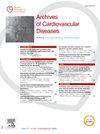虚拟现实技术在静脉窦房间隔缺损修复中的应用
IF 2.3
3区 医学
Q2 CARDIAC & CARDIOVASCULAR SYSTEMS
引用次数: 0
摘要
背景手术矫正是静脉窦性房间隔缺损(SVASD)的标准治疗方法。经导管闭合最近已通过在SVC中放置涂层支架在选定的解剖结构良好的患者中实现。然而,患者的选择仍然具有挑战性。目的:我们旨在评估虚拟现实(VR)在选择手术或经导管闭合患者中的应用。方法纳入7例患者,中位年龄50岁(成人5例,婴儿2例)。使用DICOM to PRINT软件(v1.0.3.3038, 3D Systems Inc ., USA)获得患者特定的心脏扫描仪数据,以创建准确的心脏3D模型。然后将心脏模型导入VR环境(HTC Vive Pro 2和SteamVR 2.2.3),允许在沉浸式细节中探索解剖结构。结果在所有患者中,VR提供了对SVASD解剖结构的全面了解,包括其与邻近结构的关系。在5例成人病例中的3例中,VR通过在SVC内放置OPTIMUS XXL®支架,确认了无肺静脉阻塞的经皮矫正的可能性。对于最后2名成人,VR证实心脏内解剖结构不利于经皮治疗,有肺静脉阻塞的风险。这些发现与所有5名患者的多学科报告一致,这在模拟之前是未知的(图1、图2、图3)。在两个儿科病例中,它促进了手术技术的选择(隧道补片或Warden手术)。外科医生和心脏病专家报告说,空间意识增强了,对潜在手术方法的洞察力也提高了。结论vr促进了跨学科的合作,由于其能够提供沉浸式的、患者特异性的可视化,它似乎是SVASD修复介入和手术计划的一个有价值的工具。进一步的研究需要在更大的队列中验证其有效性,并评估其对手术和介入性结果的影响。本文章由计算机程序翻译,如有差异,请以英文原文为准。
Virtual Reality for surgical and interventional planning for sinus venosus atrial septal defect repair
Background
Surgical correction is the standard of care for sinus venosus atrial septal defects (SVASD). Transcatheter closure has been recently achieved through placement of a coated stent in the SVC in selected patients with favorable anatomy. However, patient's selection stays challenging.
Objectives
We aimed to assess the utility of the Virtual reality (VR) in patient selection for surgical or transcatheter closure.
Methods
7 patients were included with a median age of 50 years (5 adults et 2 infants). Patient-specific cardiac scanner data were obtained to create accurate 3D models of the heart using DICOM to PRINT software (v1.0.3.3038, 3D Systems Inc, USA). Cardiac models were then imported into a VR environment (HTC Vive Pro 2 and SteamVR 2.2.3), allowing exploration of the anatomy in immersive details.
Results
In all patients, VR provided a comprehensive understanding of SVASD anatomy, including its relationship with adjacent structures. In 3 of 5 adult cases, VR allowed for confirmation of the possibility of percutaneous correction without pulmonary vein obstruction by placing the OPTIMUS XXL® stent in the SVC. For the last 2 adults, VR confirmed that the intra-cardiac anatomy was unfavorable for the percutaneous treatment with a risk of pulmonary vein obstruction. These findings were consistent with the multidisciplinary reports for all five patients, which was not known before the simulation (Figure 1, Figure 2, Figure 3).
In the two pediatric cases, it facilitated the choice of surgical technic (tunnelization patch or Warden procedure). Surgeons and cardiologists reported enhanced spatial awareness and improved insight into potential surgical approaches.
Conclusion
VR facilitated interdisciplinary collaboration and seems to be a valuable tool for interventional and surgical planning in SVASD repair due to its ability to provide immersive, patient-specific visualization. Further research is warranted to validate its efficacy in larger cohorts and assess its impact on surgical and interventional outcomes.
求助全文
通过发布文献求助,成功后即可免费获取论文全文。
去求助
来源期刊

Archives of Cardiovascular Diseases
医学-心血管系统
CiteScore
4.40
自引率
6.70%
发文量
87
审稿时长
34 days
期刊介绍:
The Journal publishes original peer-reviewed clinical and research articles, epidemiological studies, new methodological clinical approaches, review articles and editorials. Topics covered include coronary artery and valve diseases, interventional and pediatric cardiology, cardiovascular surgery, cardiomyopathy and heart failure, arrhythmias and stimulation, cardiovascular imaging, vascular medicine and hypertension, epidemiology and risk factors, and large multicenter studies. Archives of Cardiovascular Diseases also publishes abstracts of papers presented at the annual sessions of the Journées Européennes de la Société Française de Cardiologie and the guidelines edited by the French Society of Cardiology.
 求助内容:
求助内容: 应助结果提醒方式:
应助结果提醒方式:


